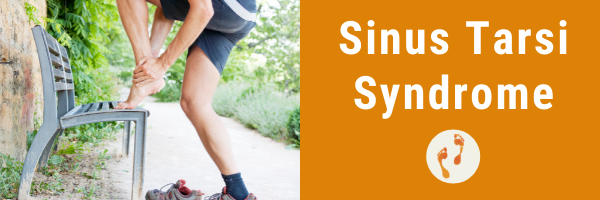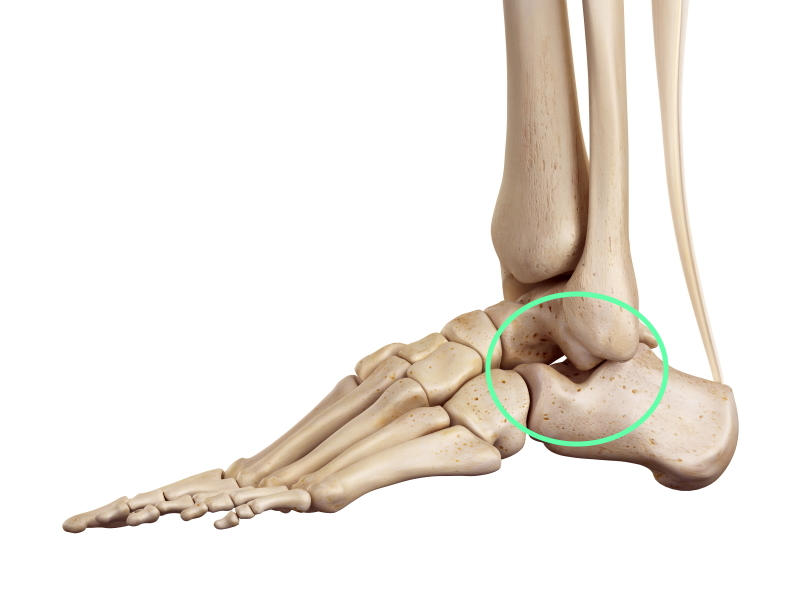Sinus Tarsi Syndrome

Sinus tarsi syndrome is a cause of pain on the outside of the ankle. Specifically, the pain is located in a space called the sinus tarsi, located between a bone called the talus that forms part of your ankle, and the heel bone. You can see the location of the sinus tarsi in the image.
The sinus tarsi has a number of nerves, ligaments and blood vessels that run through it. When these structures are damaged, which is often a result of traumatic injuries like ankle sprains that swell and compress this space, residual scar tissue that takes up space after an ankle injury, or problems with the biomechanics or posture of the feet such as having flat feet, pain at the sinus tarsi can start. Symptoms can include:
 Pain at the outside the ankle, or a pinching sensation
Pain at the outside the ankle, or a pinching sensation- Swelling in the area of the sinus tarsi
- Ankle instability or weakness when walking
- Pain worsened when turning the foot out
- Pain and difficulty walking on uneven surfaces, like over rocks
- Burning, numbness or tingling radiating from the area if nerves are being compressed within the sinus tarsi
- Symptoms that are exacerbated by activity, including standing and walking, and eased with rest
Treating Sinus Tarsi Ankle Pain
Treating sinus tarsi syndrome starts by reducing the painful symptoms and reducing the swelling, as swelling is one of the causes of sinus tarsi pain. You can start at home by icing the area and avoiding movements that produce pain. We start with strapping the feet for many of our patients, who often find instant relief by keeping the sinus tarsi in a naturally more opened position and giving the damaged structures inside some room.
Next, we’ll look at what is causing the pain and address this. This is very important in preventing this pain from recurring in the future. Your exact treatment will depend on your cause, but may include:
- The EXO-L brace for those with a history of ankle sprains or ankle instability
- Custom foot orthotics if a flat foot posture or other biomechanical abnormalities contributed to the pain, as well as to help improve the stability of the ankle
- Stretching and strengthening program to help any muscle imbalances around the foot and ankle, particularly around the calf muscle which when tight, affects how the foot moves through gait and can contribute to pain
- Footwear assessment to help with ankle stability and good foot and ankle support
Surgery is generally not required for sinus tarsi syndrome as the condition usually responds well to the non-surgical treatment methods we’ve outlined, plus any surgery carries significant risks. Cortisone injections, however, can be useful in helping to temporarily alleviate the pain and inflammation, which can allow you to comfortably focus on your rehabilitation for long-term management and prevention.
If you’re unsure what’s causing your ankle pain, book in with our podiatrists for an assessment to uncover what is causing your pain, why, and how to treat it.
Frequently Asked Questions
Is Sinus Tarsi Syndrome a chronic condition?
The prognosis for Sinus Tarsi Syndrome varies depending on the severity and the effectiveness of treatment. With proper care, many people can manage the condition and find relief from their symptoms.
Can Sinus Tarsi Syndrome be caused by a previous ankle sprain?
Yes, previous ankle sprains can sometimes lead to instability in the midfoot, contributing to the development of Sinus Tarsi Syndrome.
Can Sinus Tarsi Syndrome affect both feet at the same time?
Yes, Sinus Tarsi Syndrome can affect one or both feet simultaneously, depending on the underlying causes and contributing factors.
Are there exercises that can help with Sinus Tarsi Syndrome?
Yes, physical therapy and specific exercises can be beneficial in improving foot and ankle strength, stability, and range of motion, which can aid in managing Sinus Tarsi Syndrome. Your podiatrist will likely include this in your management plan, depending on your specific symptoms and circumstances.
Can Sinus Tarsi Syndrome lead to long-term disability?
While it can if it is left unmanaged, with proper diagnosis and treatment, most people with Sinus Tarsi Syndrome can manage their symptoms effectively and avoid long-term disability.


